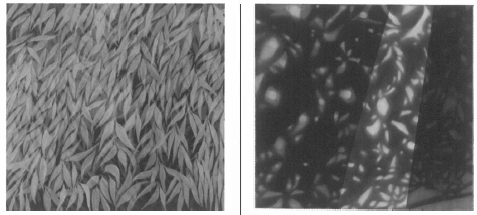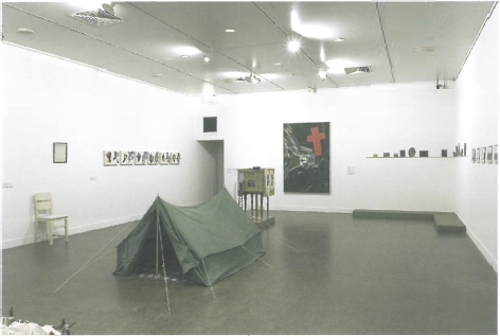
Troy Ruffel's exhibition Mirrored Worlds is a collection of understated images of the natural world, rendered in an original and technically assured way, breathing life into a theme that is by no means new.
The show brings to a climax several years of travel, including residencies in Malaysia and Scotland, which inform much of the work.
In its strong and impressive close hanging and the general unity of colour, Mirrored Worlds fortuitously functions as an installation, with over thirty meticulously painted medium-scale works enveloping viewers as they engage with them. Inspired by Ruffels' sense of wonder at the landscape, the paintings form a very coherent and striking whole, depicting clouds, pools of water, swirls of leaves, shadows, spiky tree branches, grasses and flowers.
These are the kinds of subjects which Ruffels has explored in his better-known digital images; he has established himself, at least in this state, as an innovative digital printmaker. The link between his two bodies of work is clear, yet it is unusual to see an artist display such facility in a medium, in this case painting, so dissimilar to his usual output.
The subject matter is presented as reflected images, hence Ruffels' idiosyncratic technique, which takes the works out of the realm of mere 'nature studies'. The works are almost photo-realist in form and utilise the device of a limited palette with a light-toned background and a deeper-toned, soft-focus foreground detail. Generally, the paintings are executed in soft greens, with a few works in grey, blue-grey and black providing contrast. Ruffels' palette might arguably be too bland for some tastes, but I found it subtle and seductive.
In most of the paintings there is a resemblance to traditional wallpaper designs and to muted-focus photography. Crystal poplar with its haunting black background and spiky white branch tips has the purity of a silver gelatin photograph.
The individual works are painstakingly created depictions of ephemeral nature. Titles are generally a literal summary of each work's content. Falling leaf, branch, pool I, II and III and Mirrored world present a profusion of meticulously painted leaves, carefully crafted into idealised patterns. This is not untamed nature; the artist's hand and eye intervene in the creation of the forms in the images.
Clouds and bodies of water are painted in striking monochromes and minimal detailing in works such as Clouds of stone while Murmur of light II uses tonal variation and limited colour, with unusual geometric form to replicate a shaft of light.
Two larger pieces round out and extend the concerns of the main body of works on display. A falling light (oil on canvas) is a substantial work which extends the 'leaf/shadow on soft green' subject matter and technique, creating a particularly powerful, atmospheric effect. Sampled reality, in photo-anodised aluminium, presents forty-two small panels in seven serried rows, depicting, in full colour, the kinds of visual topics found in the rest of the exhibition: droplets of water, a spider's web, leaves, grasses and clouds – and two or three recognisable, but ultimately unidentifiable, details of a dark green automobile. Again, these subjects are in keeping with the artist's repertoire of images. As depicted in bright colour they suggest the influence on Ruffels of the tropical world and provide a strong counterpoint to the rest of the exhibition.
Within the works in the exhibition there is a variety of topic and form, balanced with unifying elements. The paintings invite the kind of contemplation that Ruffels describes: ' I pause as I watch the spiralling undulations of leaves twisting and warping in mirrored worlds beneath my feet.'












